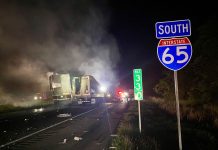The course of the Mill Race Marathon may lose its namesake a few years from now.
The CSX and Louisville & Indiana Railroads can’t commit to keep trains from running through the downtown area during the annual late-September running event after next year, Columbus Mayor Jim Lienhoop said.
That’s when as many as 22 trains a day start going through the park, compared to eight now.
But just because the railroads can’t make that commitment now doesn’t mean they won’t make it later, Mill Race Marathon Organizing Committee member Randy Stafford said.
After a stopped locomotive disrupted the 2014 marathon, the railroads committed to a 5 a.m. to 11 a.m. window where trains would not come through the park and downtown area, Stafford said.
Because substantially more trains will begin coming through Columbus by late next year, the committee is already planning a new route for the 5K race in subsequent years, taking participants up Washington Street and looping around the Donner Park area before they return downtown, Stafford said.
Such a change would enable the committee to request only a two-hour, train-free window between 6:30 and 8:30 a.m. on race day, which Stafford said would be sufficient to ensure the half and full marathon runners get through the park.
“There’s room for optimism they’ll approve our request,” race coordinator Joel Sauer said. “But if it doesn’t happen, it’s not a huge deal. The impact on the course would be minor.”
After being made aware of the potential problem several months ago, the marathon’s planning committee drew up a number of contingency plans, committee lead Laura Chasse said.
Even before the increasing train traffic was announced last fall, organizers had already laid out an alternative course for the full marathon in case Mill Race Park became flooded, Stafford said.
While fine-tuning may be required, Stafford doesn’t expect any problems regarding the 26.2-mile course.
“It’s easier to add distance to the full marathon,” Stafford said. “The half-marathon is where things might get constrained. There are limitations to where we can add distance.”
But there’s another factor that could come into play. Construction of a overpass at the State Road 46/State Road 11 intersection could force even more changes to the route, Stafford said.
“We know we’ll be able to get across the river on the Third Street Bridge,” Stafford said. “But we don’t know if we’ll be able to get back across on the Robert N. Stewart bridge.”
Some time will be required to certify a new course to maintain the event’s status as a Boston Marathon-qualifying event, as well as for insurance purposes, Chasse said.
But as long as final changes are in place two months before the September 2019 marathon, Stafford said he doesn’t foresee any problems.
Sauer agrees, adding runners will still go past the park that is the race’s namesake — even if they don’t go through it.
“But it would still be a bit of a bummer to lose the park,” Sauer said. “It’s such a cool area.”
[sc:pullout-title pullout-title=”Inside today” ][sc:pullout-text-begin]
Learn about Mill Race Marathon’s anti-doping policy on The Rundown page in Sports, Page XX.
[sc:pullout-text-end]




